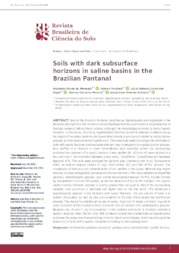Soils with dark subsurface horizons in saline basins in the Brazilian Pantanal.
Soils with dark subsurface horizons in saline basins in the Brazilian Pantanal.
Summary: Soils in the Brazilian Pantanal classified as Espodossolos and registered in the literature diverge from the central concept of pedogenesis by podzolization, especially due to the high values of pH and basic cations, although the morphology is similar to that of spodic horizons. In this sense, this study hypothesized that the neutral to alkaline conditions along the edges of the saline basins in the Lower Nhecolândia region do not inhibit the podzolization process nor the development of spodic soils. The objectives were to analyze the attributes of soils with spodic features and evaluate whether they correspond to a podzolization process. Four profiles in a transect in Lower Nhecolândia were selected, where the morphology indicated the presence of a spodic horizon. Three profiles (P1, P2 and P4) were located in a bay and one in the transition between a bay and a "cordilheira" (small elevation between lagoons) (P3). The soils were analyzed for particle size, chemistry and X-ray fluorescence (XRF), as well as organic carbon (C org), total carbon (TC) and XRF of the nodules. The complexity of features and characteristics of soil profiles in the Lower Nhecolândia region indicate multiple pedogenetic processes in this environment. The characteristics of all profiles denote a redoximorphic process: poor profile development (except for P3), mottles formed by precipitation of Fe and Mn oxides, as well as presence of Fe and Mn nodules. The organic matter content of these nodules is mostly greater than or equal to that of the surrounding material, and aluminum is relatively not higher than in the fine earth. This reinforces a rexodimorphic process in the horizons with spodic features. The occurrence of sodic and solodic characters, as well as clay accumulation in P3 also characterize the sodification process. The neutral to alkaline pH values in water, high sum of bases and low C org and Al oxide contents of the studied soils all contradict the occurrence of a podzolization process. However, Fe, Al and C org accumulation in the nodules and some B horizons indicate a spodic character. Also, the fact that SiBCS criteria classify the studied soils as Espodossolos indicates the relevance of establishing limits for chemical attributes, which would adjust the taxonomy of soils with a spodic character according to their pedogenesis
Publication year: 2022
Types of publication: Journal article
Unit: Embrapa Soils
Observation
Some of Embrapa's publications are published as ePub files. To read them, use or download one of the following free software options to your computer or mobile device. Android: Google Play Books; IOS: iBooks; Windows and Linux: Calibre.
Access other publications
Access the Agricultural Research Database (BDPA) to consult Embrapa's full library collection and records.
Visit Embrapa Bookstore to purchase books and other publications sold by Embrapa.

